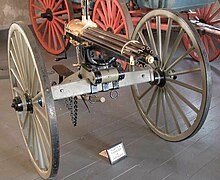| Revision as of 14:50, 13 May 2008 view sourceClueBot (talk | contribs)1,596,818 editsm Reverting possible vandalism by 216.162.22.1 to version by CapitalR. False positive? Report it. Thanks, User:ClueBot. (372622) (Bot)← Previous edit | Revision as of 13:25, 14 May 2008 view source 216.162.22.1 (talk) →ReferencesNext edit → | ||
| Line 26: | Line 26: | ||
| ==References== | ==References== | ||
| {{Reflist}} | {{Reflist}} | ||
| suckmydick.com | |||
| ==External links== | ==External links== | ||
Revision as of 13:25, 14 May 2008
American Civil War Weapons were used during 1861-1865 by Union and Confederate troops. It was considered the first "modern" war in history. The American Civil War saw development in existing weapons, such as rifles, and the use of new weapons.
Handheld firearms

- Colt revolvers- The most popular version in the Union was the Colt Army Model 1860, which was a .44 caliber six-shot revolver. The double-action revolver was briefly used in the Western theater of the war, until the U.S. Ordinance Department persuaded Starr Arms Co. to create a single-action variant after the discontinuation of the Colt. The company eventually complied, and the Union acquired 25,000 of the single-action revolvers for $12 each.

- LeMat revolver- This revolver was perhaps the most well-known foreign designed revolver in the Civil War. It had two barrels, one on top of the other. The top barrel could fire up to nine .40 caliber revolver bullets, the bottom could fire a 16 gauge shotgun shot, making it a deadly weapon. The creator, a French doctor living in New Orleans, Jean Alexander Francois Le Mat, moved back to France to create more revolvers for the Confederacy. The French-made revolvers, however, were unreliable, and he eventually contracted Belgian and English companies.
- In addition, stocks were made that could be screwed onto the butt of the pistol. The stock allowed the handgun to be held at the shoulder, increasing range and accuracy.
Rifles, carbines, and muskets
The American Civil War saw many traditional muzzle-loading rifles, as well as the new breech-loading carbines and rifles. The advent of the rifle saw a change in the traditional mars firing technique, instead creating a more deadly frontal assault tactic. Like in artillery, the Union was better equipped with rifles, as the blockade of the South could only be penetrated by smugglers, who often imported foreign models .
Grenades
It is a little known fact that the Civil War did have crude hand grenades equipped with a plunger that would detonate the device upon impact of the target. The North relied on experimental Ketchum grenades, with a tail to ensure the nose would strike the target and start the fuse. The Confederacy used spherical hand grenades that weighed about six pounds, sometimes with a paper fuse. They also used Rains and Adams grenades, which were similar to the Ketchum in appearance and mechanism.
Gatling Gun

The Gatling Gun was a multi-barreled, .58 caliber repeating machine gun that was capable of firing off 1000 rounds per minute that was created by Dr. Richard Jordan Gatling. The cartridges were fed by a hand crank. As the crank was turned, a barrel revolved into place before the breech, a cartridge was inserted and fitted, and the empty shell was extracted in a continuous cycle.
As there were multiple barrels, a Gatling gun could be fired for long periods of time without overheating. It was not as popular as common rifles, though, and saw very little action in the Civil War.
Famous Weapons
The Dictator was a large mortar, capable of launching a 220 lb. projectile into the air, over a mile high. The projectile than exploded into hundreds of fragments, each about the size of someone's fist, rendering it more deadly.
References
- Weapons of the American Civil War. Retrieved 2 May 2007eff.
- Battle of 1st Bull Run. Retrieved 3 May, 2007.
suckmydick.com
External links
- Small Arms of the Civil War
- Artillery, small arms and edged weapons
- Field Artillery of the Civil War